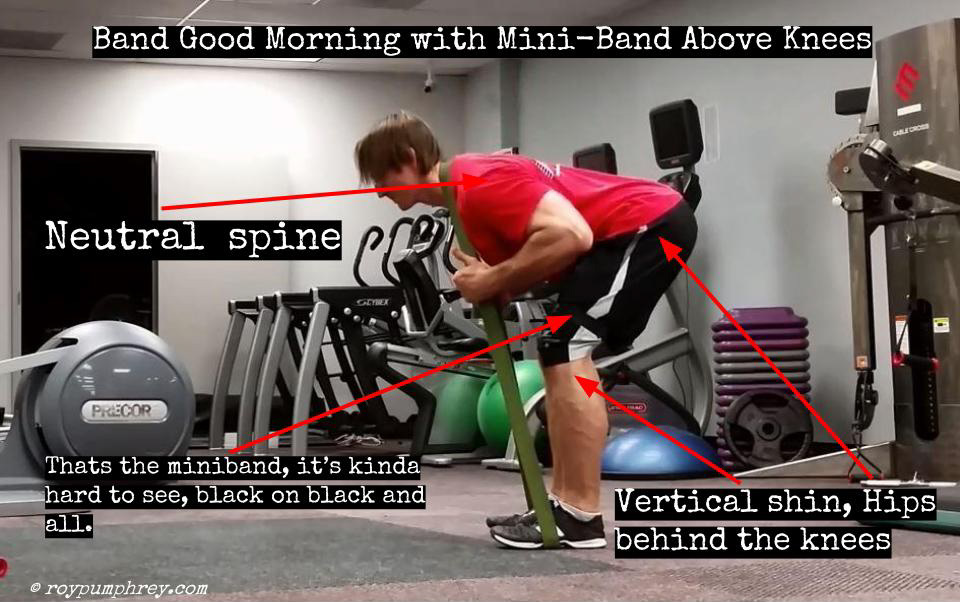Ohh low backs, how you ruin our lives..
Truth is, it’s not our low backs fault.
It’s our fault: we develop faulty movement patterns and then unknowingly do things that exacerbate the issue.
In this case it’s the ability to hinge at the hips.
This is mostly comes down to 2 factors:
#1: Initiating Movement at the Low Back
#2: A lack of Glute Activation
Once we can initiate movement from the hips and turn the glutes on everything else falls in line and you might actually start loading your hips instead of your low back.
But I Already Know How To Hinge:
It’s fairly common for experienced exercises to overreach lower back to create a “stable” surface to pull from instead of loading the glutes, hamstrings and “core”.
That’s usually a result of the glutes not doing what they should do to “set” the hip-joint into a neutral position.
Instead these people shut the glutes down, and rely on the errectors/ hamstrings and low back structures to provide stability.
And that’s ok, until your back is killing you all the time and it’s not ok anymore. Which will inevitably happen if you load it this way enough.
Ohh what to do, what to do.
Band Good Morning With Mini Band Above the Knees:
YouTube it (and subscribe to my channel) Here:
How to do it:
- Use a shoulder to slightly wider stance.
- Mini-Band, or Hip Circle above the knees
- Put a stretch band on the upper back, not the neck.
- Toes straight ahead, hips externally rotated (screwed out) into the floor pushing out on the band
- Ribcage down“on” the abs
- Soft Knees, not bent forward, soft….
- Push the hips back, maintaining a neutral spine, and glute tension.
- Push back as far as you can maintain a vertical shin and don’t round over.
- Squeeze the butt hard and think about driving the hips forward THROUGH, not to, but through lockout
- Stand on the glutes. Butt should be squeezed tight at the top. <—-DO NOT let the glutes turn off short of lockout.
Common Errors:
- Rounding the upper back.
- Bending “over”, rather than pushing back.
- Squatting, allowing the shins to move forward.
- Not pushing against the mini band around the knees, allowing the glutes to shut off.
- Rushing to the top and overextending the lumbar spine instead of locking out the hips.

Troubleshooting for Trouble People:
Alright you suck at hinging:
The not so quick fix that works for 90% of people, half the time.
- Bench goes behind the knees. Shins should be vertical with the calves/ knees barely touching the bench.
- Cue to push the butt back as far as possible behind the bench, but NEVER lose contact with the bench. If they squat, the shins move forward and its instant feedback, if they stiff legg it, they’ll drive into the bench and get instant feedback.
You overextend the lumbar:
Bring the chin down so the neck stays in neutral.
You round over:
Go slower and focus on keeping the torso in line and “t-shirt logo up”. Use a 5 second eccentric (lowering) count.
The Band Good Morning with Mini Band above the knees is awesome because:
- Reinforces a hip hinge while deloading where the lumbar vertebrae are most at risk.
- Turns the glutes on from the start and keeps them on.
- Challenges the user to maintain a good solid position through the entire hip hinge (pull position) range of motion.
Start light and work up.
Frequently, I have clients begin this exercise with a very thin band around the neck and a green (average) Perform Better mini band around the knees. *Update: I usually use a Sling Shot Hip Circle now, cause it gives better feedback and it’s way easier to get on and off.
While this isn’t very much tension, it ensures that the load on the back is about as minimal as it can get and any sloppy reps wont have much of a chance to create an injury.
Keep in mind, it doesn’t mean sloppy reps are ok, but if you can hinge without load already, you’ve got to move against something to learn what it feels like to brace and move maintaining tension.
If you constantly find yourself defaulting into an overextended lumbar position use this before the pulling movements in your workout to warmup and reinforce proper mechanics.


